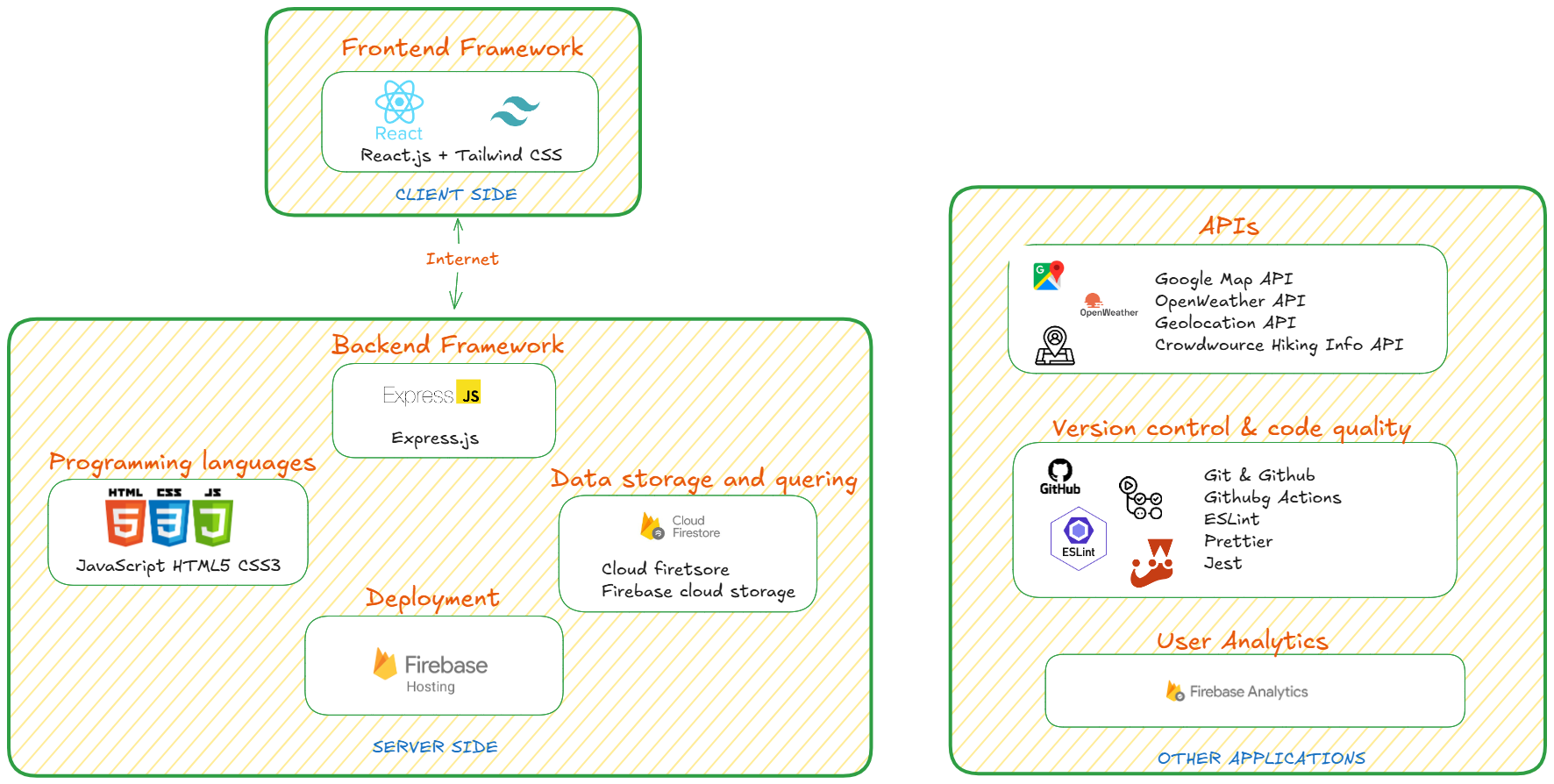Hiking-Logbook
Technology Stack for the Hiking Logbook Web Application
The Hiking Logbook is built using a modern, integrated technology stack designed to streamline development, ensure scalability, and deliver a seamless user experience. Each technology has been carefully chosen to align with the project requirements for functionality, maintainability, and performance.
1. Overview
The Hiking Logbook is a single-page web application where the frontend (React + Tailwind) communicates directly with Firebase backend services via Firebase SDKs. This eliminates the need for a self-hosted backend, reducing infrastructure complexity.
User actions, such as logging a hike or checking the weather for a trail, trigger either:
- Direct data reads/writes to Cloud Firestore
- Calls to Cloud Functions for additional logic or external API requests
External APIs (Google Maps, OpenWeather, Geolocation, Crowdsource Hiking Info) provide real-time, location-based services, integrated through Firebase Cloud Functions or directly in the frontend where appropriate.
All deployments are managed through GitHub Actions to Firebase Hosting, ensuring that every update passes linting, testing, and CI/CD checks before going live.

Diagram showcasing the different components of the tech stack.
2. Programming Languages
- JavaScript (ES6+) – The primary programming language for both the frontend and backend, allowing a unified development experience. Using JavaScript across the stack enables faster development and either knowledge sharing within the team.
- HTML5 – Structures the frontend content and ensures semantic, accessible design.
- CSS3 – Styles and ensures responsive layouts, supported by Tailwind CSS.
3. Frontend
The frontend forms the user interface of the Hiking Logbook, where users can log hikes, view routes, and check the weather.
Framework: React.js
- Purpose: Build a fast, interactive, and component-based UI.
- Reasons:
- Highly popular and well-supported
- Efficient state management and reusable components
- Large ecosystem of third-party libraries
Framework: Tailwind CSS
- Purpose: Rapidly design responsive and modern UI.
- Reasons:
- Utility-first CSS framework
- Integrated with React for quick prototyping
- Mobile-first and highly customizable
Additional Frontend Tools
- React Router – Client-side routing for smooth navigation between views.
- Jest & React Testing Library – Unit and integration testing to reduce bugs in production.
4. Backend as a Service (BaaS) – Firebase
Instead of a custom backend, Firebase provides backend infrastructure with high reliability and scalability.
Firebase
- Purpose: Authentication, database, hosting, and backend services without manual server setup.
- Reasons:
- Real-time database support
- Built-in authentication providers
- Free tier for MVP development
- Seamless React integration
Firebase Services Used
- Firebase Authentication – Independent, secure user sign-in system
- Cloud Firestore – NoSQL database for logbook data, planned hikes, achievements, and friend lists
- Firebase Hosting – Deployment of frontend
- Firebase Functions – Serverless backend logic
Framework: Express.js
- Purpose: Build lightweight, flexible server-side apps and APIs.
- Reasons:
- Minimal framework with flexible structure
- Simplifies RESTful API creation
5. APIs & External Services
The Hiking Logbook integrates several APIs to enhance functionality:
- Google Maps API (or Leaflet) – Trail maps, route planning, location search.
- OpenWeather API – Real-time weather data for hiking locations.
- Geolocation API – Tracks live location and distance during hikes.
- Crowdsource Hiking Info API – Real-time hiking events and activities from the global community.
6. Development & Code Quality Tools
- Git & GitHub – Version control, ensuring safe collaboration through feature branches, pull requests, and code reviews.
- GitHub Actions (CI/CD) – Automates build, linting, testing, and deployment, ensuring that only tested and compliant code is deployed.
- ESLint – Automatically detects and flags code issues, enforcing consistent coding standards.
- Prettier – Formats code to maintain visual consistency across the project.
- Jest – Provides a testing framework for both frontend and Firebase Functions, ensuring correctness and preventing regressions.